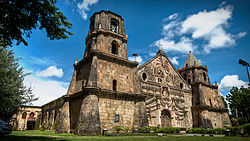Miag-ao
| Miagao | |
|---|---|
| Municipality | |
| Municipality of Miagao | |
 |
|
 Map of Iloilo with Miag-ao highlighted |
|
| Location within the Philippines | |
| Coordinates: 10°39′N 122°14′E / 10.65°N 122.23°ECoordinates: 10°39′N 122°14′E / 10.65°N 122.23°E | |
| Country | Philippines |
| Region | Western Visayas (Region VI) |
| Province | Iloilo |
| Legislative district | 1st district of Iloilo |
| Barangays | 119 |
| Government | |
| • Mayor | Macario N. Napulan (Liberal) |
| • Vice Mayor | Leonardo Naldoza (Liberal) |
| Area | |
| • Total | 156.80 km2 (60.54 sq mi) |
| Population (2015 census) | |
| • Total | 67,565 |
| • Rank | 7th (Province of Iloilo) and 9th (Western Visayas) |
| • Density | 430/km2 (1,100/sq mi) |
| • Languages | Kinaray-a, Hiligaynon, Tagalog, English |
| Time zone | PST (UTC+8) |
| ZIP code | 5023 |
| IDD : area code | +63 (0)33 |
| Website | www |
Miagao (also written Miag-ao) is a first class municipality in the province of Iloilo, Philippines. According to the 2015 census, it has a population of 67,565 people.
Miagao is considered as the "Onion Capital of the Visayas". The town center of the municipality lies on the western bank of the Tumagbok River, the largest river in the municipality. The poblacion is made up of eight barangays.
The town holds their patronal fiesta in honor of St. Thomas of Villanova (more commonly known as Sto. Tomas de Villanueva) every September 22 that lasts several days. The town is also the location of one of the Baroque Churches of the Philippines, the Miagao Church, which was inscribed as a UNESCO World Heritage Site.
The name of Miagao has many disputed etymologies. One of the most popular, and probably the most widely accepted version is that the name of the town was derived from a plant named Miagos. Miagos or Osmoxylon lineare is a flowering plant from the family Araliaceae that used to grow abundantly in the area when the Spaniards came. Because of its abundance in the area, the Spaniards named the place Miagos which later became Miagao. Another version, according to Rev. Fr. Lorenzo Torres of Igbaras, is that a native named "Miyagaw" was asked by the Spaniards for the name of the place but gave his name instead.
Miagao gained its independence as a municipality in 1716. Prior to that, it used to be a part of an arrabal of four different towns in southern Iloilo. Until 1580, Miagao was an arrabal of Oton. From 1580 until 1652, it was an arrabal of Tigbauan. It was an arrabal of Suaraga (now San Joaquin) from 1652 to 1703 and before becoming independent, it became an arrabal of Guimbal from 1703 to 1716. In 1731, Miagao had its first capitan and teniente mayor (now equivalent to mayor and vice mayor) after an election was held in Guimbal under the supervision of Victorino C. Ma., an authorized representative of the governor.
...
Wikipedia

